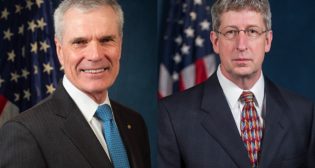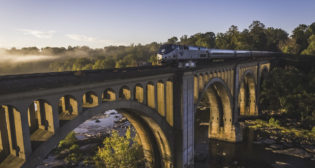
Fighting fire with fire trains
Written by Bruce E. Kelly, Contributing Editor
From the May 2016 issue of Railway Age: Specialized equipment and training help protect assets from wildfire damage. Every summer, particularly in the Western U.S. and Canada, fires triggered by lightning or human activity are an ordinary occurrence. During recent summers, however, wildfires have put railroads increasingly in the crosshairs.
In 2014 and 2015, fires that spread to roughly 300,000 acres in north-central Washington broke previously held records for that state. The blaze in 2014 destroyed several communities and caused trestle and track damage to short line Cascade & Columbia River Railroad. Other fires have led to closures of BNSF and Union Pacific main lines in Washington, Idaho and Montana, and prompted the deployment of firefighting resources throughout the region.
Measured individually, these recent wildfires were smaller than some recorded in prior decades. Burn complexes of 3 million acres or more struck the mountains of British Columbia and Alberta in 1950, Idaho and Montana in 1910, and New Brunswick in 1825. A cross section taken from an ancient Ponderosa pine in western Montana revealed scars from no less than 20 fires dating clear back to 1612, all but one of them occurring prior to 1892. The potential for wildfires to damage railway property and disrupt service has been around since the first locomotives breathed steam.
 Today, railroads place an increased emphasis on stopping wildfire damage before it happens. UP spokesman Francisco Castillo said, “Our focus has been on preventative measures, so that we’re ready to respond in the event wildfires were to reach UP property.” Castillo outlined those measures for Railway Age: “We have an active Fire Risk Assessment program to determine our high risk territories. Water tenders are strategically staged throughout critical mountain pass territory (i.e. Oroville and Dunsmuir, Calif.; Pendleton, Ore.). Our team monitors the U.S. Forestry wildfire data 24/7. We participate in joint meetings with U.S. Forestry and relevant state agencies in high risk territories to prepare for any incident.”
Today, railroads place an increased emphasis on stopping wildfire damage before it happens. UP spokesman Francisco Castillo said, “Our focus has been on preventative measures, so that we’re ready to respond in the event wildfires were to reach UP property.” Castillo outlined those measures for Railway Age: “We have an active Fire Risk Assessment program to determine our high risk territories. Water tenders are strategically staged throughout critical mountain pass territory (i.e. Oroville and Dunsmuir, Calif.; Pendleton, Ore.). Our team monitors the U.S. Forestry wildfire data 24/7. We participate in joint meetings with U.S. Forestry and relevant state agencies in high risk territories to prepare for any incident.”
UP spends an estimated $20 million annually on vegetation control. A fire prevention program under way in the Donner Pass area of California during 2015 was “focused on 80 miles of the highest fire concentration.” UP said, “The project will clear the right-of-way of all grasses, brush and debris, and wood material (cleared trees) will be chipped on site and donated to the Rocklin Power Plant, where it can be used as a fuel source for the city.”
The rail industry’s fire-suppression efforts often go unnoticed. Some short lines operating in fire-prone areas run a hi-rail vehicle equipped with water and hoses behind each train during the height of wildfire season. Companies whose trackage runs through terrain that’s inaccessible to rubber-tired firefighting equipment will often keep one or more tank cars filled with water, outfitted with pumps and hoses, and ready to deploy at a moment’s notice.
Remarkably dry conditions during 2015 brought an early start to the fire season, with BNSF dispatching a Spokane, Wash.-based fire train on two separate occasions in mid-June to assist aerial and ground resources on that city’s outskirts. BNSF keeps similar fire trains on standby throughout the Northwest, but the role they play in protecting vital transportation corridors and supporting local agencies didn’t really get widespread attention until August 2015, when a large forest fire on the edge of Glacier National Park closed a section of U.S. Highway 2 in northwest Montana and suspended freight and Amtrak service on much of BNSF’s Northern Corridor. Two fire trains, one from Spokane and one from Havre, Mont., helped transport firefighters to and from the scene and provided protection for timber snowsheds and wood-decked bridges.
BNSF’s large fleet of firefighting rail equipment is far advanced from the basic water-filled tank cars of the past. The first of these modern fire trains to be built was in Spokane in the fall of 2007. And just in time. BNSF said, “We were just putting the final stenciling on it when it was called down to California, where a wildfire was headed toward a wooden trestle on our right-of-way.”
The Spokane fire train utilizes bulkhead flatcars that have been converted to carry three to four modular tanks, each carrying roughly 3,250 gallons of water. Swiveling water/foam cannons are mounted on elevated platforms at both ends of the train’s center car, which also carries a 500-gallon tank of aqueous firefighting foam. BNSF says, “We can reach about 300 feet up an embankment.” The train also includes a caboose that serves as a shelter and command center and houses a generator to power lights for nighttime firefighting.
BNSF built a second fire train in 2008 in Vancouver, Wash., with a different design approach. Stationed along the Columbia River at Wishram, Wash., it uses highly modified tank cars with generators and pump systems housed underneath and swivel cannons mounted on top, plus a command center caboose that’s outfitted with a spray bar that can soak wooden ties or bridges while the train is in motion. Since fire train crews often work jointly with local responders, hoses and couplings on the BNSF railcars are made compatible with fire trucks and other equipment. The cars also have siphons, which allow them to be refilled from storage tanks or natural water sources near the right-of-way.
Walter Anno, Ed Dowdy and the team of BNSF carmen in Vancouver told Railway Age, “We convert and build steel firefighting tankers. We have been building at least one a year for some time now.” They say the Wishram-based train currently has four tank cars, and other fire tank cars have been based at Vancouver, as well as Klamath Falls, Ore. The Vancouver shop has utilized two basic car types: 16,000-gallon tank cars originally built in the 1940s for water transport service on the Santa Fe Railway, and 23,000-gallon tank cars that were converted in the 1980s into fuel tenders for Burlington Northern.
Additional fire trains based on the Spokane flat car design have been stationed at Seattle, Wenatchee and Pasco, Wash. As for the rest of the BNSF system, spokesman Gus Melonas said, “For the Southwest, we have an adequate fire protection plan with equipment, manpower and material in place designed to respond as necessary, same as in the Pacific Northwest.”
Wildfires burned more than 10 million acres and destroyed more than 4,500 homes and structures across the U.S. in 2015, an all-time record, according to Agriculture Secretary Tom Vilsack. In a report released early this year, Vilsack said that 2015 wound up being “the most expensive fire season in our Department’s history, costing more than $2.6 billion on fire alone.” The U.S. Forest Service was forced to borrow from funds normally used for non-fire-related operations in order to shore up its depleted firefighting budget. Railroads that operate in wildfire country are learning that they, too, must allocate sufficient funding toward equipment, training and preventive measures. Melonas said BNSF approaches that funding with “the same strategy as with derailment response and snow removal. We invest as necessary, as this is an ongoing railroad response issue.”



